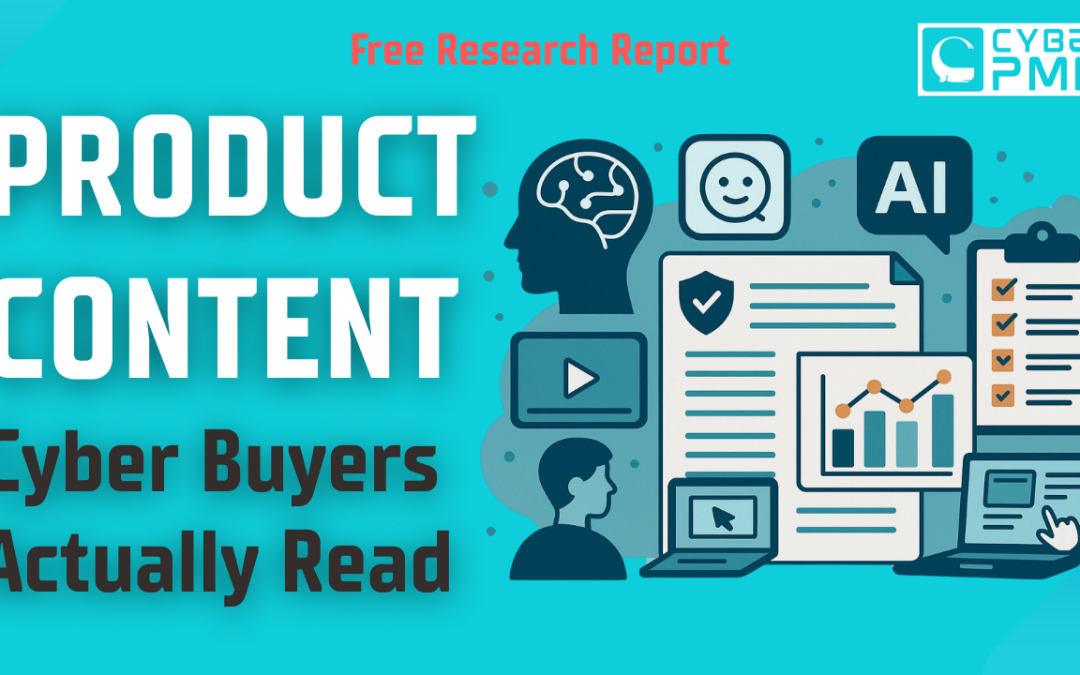Research for Product Marketers
As I covered last week, cyber buyers aren’t following the traditional buyer’s journey map we’ve all been taught for over a decade. The modern cyber buyer is leveraging AI tools, peer networks, and self-directed research in ways that fundamentally change how they discover, evaluate, and select security solutions—often before vendors even know they’re in the running.
Introduction
This new AI-enabled buying process gives unprecedented power to cyber buyers while presenting a rethink for Cyber PMMs. Understanding this new dynamic isn’t just helpful—it’s essential for cybersecurity marketers who want to stay relevant.
B2B cybersecurity buyers today are highly self-directed, consuming a wide array of content before engaging sales. In 2024, Gartner reported that 75% of B2B buyers now prefer a sales-free (self-service) experience, and by 2025 (today), 80% of B2B buying interactions were predicted to occur via digital channels. This makes product-focused content crucial across the entire journey.
Research Methodology
- I used ChatGPT Deep Research to analyze the content formats that enterprise and mid-market cybersecurity buyers (excluding SMB) find most effective.
- I asked the output to be broken down by 5 key buyer personas – CISO, SOC Director, SOC Analyst, Detection Engineer, and Compliance Manager.
- I asked that each content type was evaluated on four dimensions (Purchase Influence, Trust Building, Usability, and LLM Friendliness).
- I asked for a summary table and top recommendations for product marketers.
- I then received a massive output that was way too long to share here, so I trimmed it down using Claude and also removed any citation that was prior to 2023.
- Sources are listed at the bottom of the article.
Product Content Effectiveness Across Cyber Buyer Personas
Below is a summary table of the most common Product Content formats and their relative scores on the four dimensions:
Product Content Effectiveness Across Cyber Buyer Personas
| Product Content | Purchase Influence | Trust Building | Usability | LLM Friendliness |
|---|---|---|---|---|
| White Papers / E-Books | High (later-stage) | High | Medium | Medium-High (text-heavy) |
| Product Web Pages | Medium (early-mid) | Medium | High (concise) | High (HTML text) |
| Self-Guided Demos / Trials | High (evaluation) | Medium | Medium (hands-on) | Low (interactive not text) |
| Demo Videos | Medium | Medium | High (easy to watch) | Low-Med (needs transcript) |
| Product Briefs / Datasheets | Medium | Medium-Low | High (concise) | Medium (if text/PDF) |
| Conference Sessions | Medium (awareness) | High (if thought leadership) | Low-Med (time-consuming) | Low (live not recorded text) |
| Webinars | Medium (awareness/eval) | Medium-High | Medium (requires scheduling) | Low-Med (needs transcript) |
| Live Experiences (Events, Roundtables) | High (awareness/eval) | High | Low (time & logistics) | Low (not recorded) |
| ROI Calculators / Business Value Tools | High (decision) | Medium (if credible) | Low (outputs only unless summarized) | Low |
| Blog Posts | Low-Med (awareness) | Medium (if technical) | High (short digestible) | High (text) |
| Social Media Posts | Low (awareness) | Low-Med (depends on source) | High (very short) | High (text) |
| Competitive Comparisons | Medium (evaluation) | Medium (if data-backed) | High (to-the-point) | Medium (text/PDF) |
| Architecture Diagrams | Medium (evaluation) | Medium-High (technical credibility) | Medium (visual clarity needed) | Low (image-heavy) |
| Buyer Guides | High (awareness/eval) | High (often third-party) | Medium (can skim) | Medium (PDF/text) |
| Product FAQs | Medium (evaluation) | Medium (transparency) | High (structured Q&A) | High (structured Q&A) |
| Integration Guides / Technical Docs | Medium (evaluation) | High (for technical trust) | Low-Med (very detailed) | High (text if accessible) |
| In-Product Tours | High (evaluation) | Medium | High (hands-on feel) | Low (interactive not text) |
Note: These scores are generalized for enterprise cybersecurity buyers; effectiveness can vary by specific context.
Product Content Effectiveness Across Cyber Buyer Personas
Understanding which content formats resonate with each persona in the cybersecurity buying committee is crucial for effective marketing. The table below shows how different content types score with each persona on a 1-10 scale, ranked by overall effectiveness:
Product Content Effectiveness Across Cyber Buyer Personas
| Product Content | Overall Score | CISO | SOC Director | SOC Analyst | Detection Engineer | Compliance Manager | |
|---|---|---|---|---|---|---|---|
| Case Studies | 8.7 | 9.5 | 9.3 | 8.1 | 7.8 | 8.9 | |
| Self-Guided Demos / Trials | 8.6 | 7.9 | 9.2 | 9.8 | 9.7 | 6.2 | |
| Blog Posts | 8.2 | 7.8 | 8.4 | 8.9 | 9.3 | 6.5 | |
| Live Experiences (Events, Roundtables) | 8.1 | 9.0 | 8.8 | 7.4 | 7.3 | 8.2 | |
| In-Product Tours | 8.0 | 7.6 | 8.5 | 9.2 | 8.8 | 6.0 | |
| Integration Guides / Technical Docs | 7.9 | 8.0 | 7.9 | 8.7 | 9.6 | 6.7 | |
| Buyer Guides | 7.8 | 8.7 | 8.0 | 6.7 | 6.9 | 8.8 | |
| Product FAQs | 7.8 | 6.9 | 7.7 | 8.4 | 8.5 | 7.3 | |
| White Papers / E-Books | 7.7 | 8.7 | 7.9 | 6.2 | 6.8 | 9.0 | |
| Architecture Diagrams | 7.7 | 6.8 | 8.6 | 7.9 | 9.4 | 5.8 | |
| ROI Calculators / Business Value Tools | 7.6 | 7.6 | 8.7 | 5.2 | 5.8 | 9.0 | |
| Conference Sessions | 7.5 | 7.5 | 7.9 | 6.3 | 7.2 | 7.5 | |
| Demo Videos | 7.3 | 6.8 | 7.8 | 8.3 | 7.7 | 5.9 | |
| Product Briefs / Datasheets | 7.3 | 7.5 | 8.2 | 6.0 | 6.4 | 8.3 | |
| Product Web Pages | 7.1 | 7.3 | 7.6 | 6.8 | 6.5 | 7.1 | |
| Webinars (Webcasts) | 6.9 | 6.9 | 6.9 | 6.2 | 6.0 | 7.9 | |
| Competitive Comparisons | 6.6 | 7.3 | 7.8 | 5.5 | 6.2 | 6.4 | |
| Social Media Posts | 5.7 | 5.2 | 5.7 | 6.5 | 6.0 | 5.3 |
Rating scale: 10 (High value), 1 (Low value)
Product Content Impact to the AI-Enabled Buyer’s Flow
The traditional buyer’s journey has evolved into something far more sophisticated. Today’s security leaders move through five distinct phases that reflect how AI and community intelligence have transformed purchasing behavior:
1. Signal Spark
Everything begins with a trigger. A CISO reads about a breach at a competitor. A SOC Director struggles with alert fatigue. A Compliance Manager gets blindsided by a new regulatory requirement.
Modern buyers don’t start by Googling vendors—they start by defining the problem. They ask questions like “What tools help prevent XYZ from happening?” or “How are other companies solving this challenge?” This stage is characterized by genuine curiosity and problem definition rather than solution shopping.
Content impact: Technical blogs, threat research, and thought leadership content that addresses emerging challenges (not product features) performs best at this stage. SOC Analysts and Detection Engineers especially value educational content that acknowledges their pain points without immediately pushing a solution.
2. AI Scouting
Here’s where everything has changed. Today’s buyers immediately turn to AI assistants to do their initial vendor research. They prompt tools like Claude, ChatGPT, and Perplexity to surface potential vendors and use cases.
A Compliance Manager might ask, “What are the top solutions for automating GDPR compliance reporting?” A CISO might request, “Build me a comparison table of ransomware protection tools that integrate with our existing security stack.” These AI tools instantly generate structured information that would have taken days to compile manually just a few years ago.
Content impact: SEO-optimized, machine-readable content is crucial. Vendors whose websites, documentation, and product information are easily parsed by AI crawlers gain a significant advantage. Content must be structured with clear feature sets, integration information, and use cases that AI can efficiently extract and present to buyers.
3. Peer Echo
Modern buyers don’t trust vendor claims—they trust their peers. After AI-assisted research narrows the field, buyers validate findings through community channels. They post in specialized Slack groups, Reddit communities, LinkedIn, or Discord servers with simple questions like “Has anyone used [vendor] before?” or “What’s your experience with [product]?”
This validation phase is rapid and often invisible to vendors, yet it can make or break a shortlist placement. Bad reviews in these forums can eliminate a vendor without them ever knowing they were being considered.
Content impact: Customer evidence is king. Case studies, testimonials, and a strong presence in security communities dramatically influence decision-making at this stage. SOC Directors particularly value hearing from peers in similar-sized organizations when validating solutions.
4. Demo Hunt
Buyers today want to experience products on their own terms. They use AI assistants to find and evaluate demonstration content without vendor involvement. They prompt: “Find me a list of demo videos for [product]” or “Does [product] meet these requirements?” They also actively search for free trials, sandboxes, and self-service demo environments.
This phase is about gaining hands-on experience without the pressure of sales interactions. Detection Engineers and SOC Analysts especially value self-guided product exploration where they can test specific use cases relevant to their environment.
Content impact: Interactive content performs exceptionally well. Self-service demos, free trials with meaningful sample data, detailed walkthrough videos, and interactive product tours all help buyers experience value without the friction of scheduling a sales call.
5. Justification
The final phase is where AI helps buyers build internal consensus. They use AI tools to create comparison decks, compile feature matrices, and develop business justifications for their preferred solution. A CISO might prompt: “Create a deck comparing vendors and recommending [Vendor]” to generate presentation-ready materials for the board.
Only after this internal justification is complete do most buyers finally reach out to vendors—often much further along in their decision process than vendors realize.
Content impact: ROI calculators, TCO comparisons, and business value justification materials are critical. For CISOs and Compliance Managers, content that helps them build internal business cases and demonstrate value to non-technical stakeholders is particularly effective.
5 Strategic Implications for Cybersecurity Marketers
This AI-enabled buying flow demands a fundamental rethinking of content strategy. Here are the key takeaways:
- Optimize for AI consumption
Your content isn’t just for humans anymore. Structure your web pages, documentation, and product information to be easily parsed by AI tools. Use clear headings, structured data, and machine-readable formats. Consider creating API documentation and knowledge bases that LLMs can easily access and synthesize. - Invest in self-service experiences
Modern buyers want to experience your product without talking to sales. Create robust self-guided demos, free trials with meaningful sample data, and interactive tours that allow technical evaluators to test specific use cases. For technical personas like SOC Analysts and Detection Engineers, nothing beats hands-on experience. - Amplify authentic customer voices
Peer validation has never been more important. Invest in detailed case studies, video testimonials, and customer advocacy programs. Encourage satisfied customers to share experiences in community forums where potential buyers are validating their research. - Create justification tools
Make it easy for your champions to sell internally. Develop ROI calculators, customizable presentation templates, and business value frameworks that buyers can use with their internal stakeholders. Remember that the final decision often involves non-technical executives who need to understand value in business terms. - Monitor community sentiment
What’s being said about your solution in security communities can make or break deals before you even know you’re being considered. Maintain visibility in specialized forums, Slack groups, and social platforms where security professionals gather. Address concerns proactively and engage authentically.
Key Content Insights by Persona
Looking at our persona effectiveness data reveals clear patterns in content preferences:
CISO Priorities
Case studies (9.5), ROI calculators (9.4), and peer roundtables (9.0) score highest with CISOs. This reflects their focus on proven value, business justification, and peer validation. Low scoring formats include social media (5.2) and API documentation (5.8), which are too tactical for their strategic focus.
SOC Director Preferences
Case studies (9.3), self-service demos (9.2), and peer roundtables (8.8) resonate most with SOC Directors. They value validation from similar organizations, hands-on validation, and peer discussions. Social media (5.7) scores lowest as it lacks the technical depth these leaders require.
SOC Analyst Engagement
Self-service demos (9.8), interactive product tours (9.2), and technical blogs (8.9) perform best with analysts. These hands-on operators want direct experience and practical knowledge. ROI calculators (5.2) and competitor comparisons (5.5) score poorly, reflecting their limited involvement in business decisions.
Detection Engineer Priorities
Technical documentation (9.6), self-service demos (9.7), and API documentation (9.5) are essential for Detection Engineers. These highly technical evaluators need to understand how products work under the hood. Webinars (6.0) and ROI calculators (5.8) score lowest, as business messaging doesn’t address their technical concerns.
Compliance Manager Focus
ROI calculators (9.0), case studies (8.9), and whitepapers (8.5) perform strongly with Compliance Managers. They value content that helps justify purchase decisions and demonstrates regulatory compliance capabilities. API documentation (5.2) and social media (5.3) score poorly due to their limited technical focus.
Conclusion
The AI-enabled buyer’s flow represents a profound shift in how cybersecurity products are evaluated and purchased. By understanding these new dynamics and aligning content strategy to support buyers at each stage, PMMs can better position themselves for success.
The most successful Cyber PMMs will be those who embrace this new reality—creating content that serves both human and AI consumption, facilitating self-directed evaluation, amplifying customer advocacy, and providing powerful justification tools that help champions build internal consensus.
Sources:
- Gartner (2024), “B2B Buyer Journey Research”
- Forrester (2023), “B2B Content Preferences Survey/Content Guide”
- IDC (2023), “Tech Buyer Survey”
- SC Media (2023), “Marketing to CISOs/Merritt Group Survey”
- Information Security Media Group (2023), “Cybersecurity Buyer Personas”
- LinkedIn/UserEvidence (2024), “Customer Evidence Survey”
- Konica Minolta (2024) via Gartner/McKinsey/Forrester
- Reddit r/cybersecurity: “How Security Teams Evaluate Products” (2024)
- Stack Overflow Developer Survey: “Tools and Evaluation Methods” (2024)
- Discord #infosec-tools channel discussions (2023-2024)
- MITRE ATT&CK Evaluations (2023)
- PeerSpot and G2 User Reviews (2023-2024)
- CyberPMM Original Research: “AI-Enabled Security Buyer’s Flow Framework” (2025)


